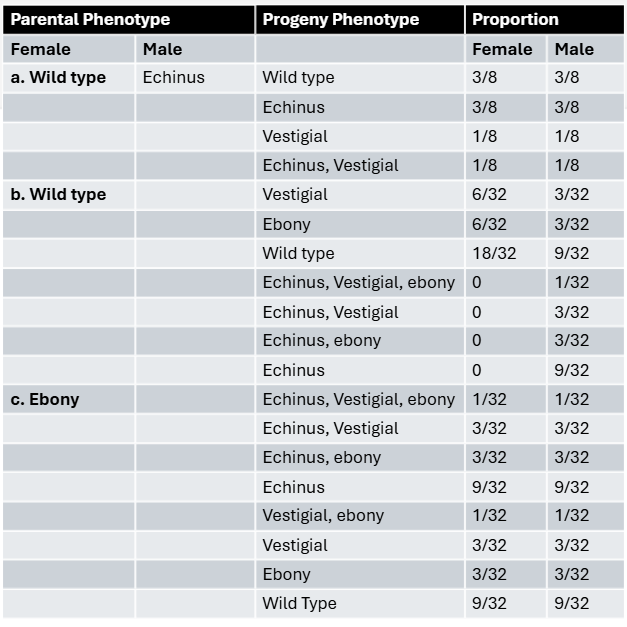In Drosophila, an X-linked recessive mutation, scalloped (sd), causes irregular wing margins. Diagram the F₁ and F₂ results if (a) a scalloped female is crossed with a normal male; (b) a scalloped male is crossed with a normal female. Compare these results with those that would be obtained if the scalloped gene were autosomal.
Table of contents
- 1. Introduction to Genetics51m
- 2. Mendel's Laws of Inheritance3h 37m
- 3. Extensions to Mendelian Inheritance2h 41m
- 4. Genetic Mapping and Linkage2h 28m
- 5. Genetics of Bacteria and Viruses1h 21m
- 6. Chromosomal Variation1h 48m
- 7. DNA and Chromosome Structure56m
- 8. DNA Replication1h 10m
- 9. Mitosis and Meiosis1h 34m
- 10. Transcription1h 0m
- 11. Translation58m
- 12. Gene Regulation in Prokaryotes1h 19m
- 13. Gene Regulation in Eukaryotes44m
- 14. Genetic Control of Development44m
- 15. Genomes and Genomics1h 50m
- 16. Transposable Elements47m
- 17. Mutation, Repair, and Recombination1h 6m
- 18. Molecular Genetic Tools19m
- 19. Cancer Genetics29m
- 20. Quantitative Genetics1h 26m
- 21. Population Genetics50m
- 22. Evolutionary Genetics29m
2. Mendel's Laws of Inheritance
Sex-Linked Genes
Problem 28
Textbook Question
In Drosophila, the X-linked echinus eye phenotype disrupts formation of facets and is recessive to wild-type eye. Autosomal recessive traits vestigial wing and ebony body assort independently of one another. Examine the progeny from the three crosses shown below, and identify the genotype of parents in each cross.

 Verified step by step guidance
Verified step by step guidance1
Step 1: Understand the traits and their inheritance patterns. The echinus eye phenotype is X-linked recessive, meaning males have only one X chromosome and will express the phenotype if they inherit the recessive allele. The vestigial wing and ebony body traits are autosomal recessive and assort independently, so their inheritance follows Mendel's laws of independent assortment.
Step 2: Analyze each cross separately by examining the phenotypes of the progeny. For the X-linked echinus trait, determine the sex and eye phenotype ratios to infer the parental genotypes, considering that males inherit their X chromosome from their mother and females inherit one X from each parent.
Step 3: For the autosomal recessive traits (vestigial wing and ebony body), use the phenotypic ratios of the offspring to deduce whether the parents are homozygous dominant, heterozygous carriers, or homozygous recessive for each trait. Remember that independent assortment means you can treat each trait separately and then combine the genotypes.
Step 4: Use Punnett squares to model each cross. For the X-linked trait, set up a Punnett square with the mother's X chromosomes and the father's X and Y chromosomes. For the autosomal traits, set up separate Punnett squares for each trait and then combine the results to predict the expected phenotypic ratios.
Step 5: Compare the expected phenotypic ratios from your Punnett squares with the observed progeny phenotypes in each cross. Adjust the assumed parental genotypes accordingly until the predicted ratios match the observed data, thereby identifying the most likely genotypes of the parents in each cross.
 Verified video answer for a similar problem:
Verified video answer for a similar problem:This video solution was recommended by our tutors as helpful for the problem above
Video duration:
1mPlay a video:
Was this helpful?
Key Concepts
Here are the essential concepts you must grasp in order to answer the question correctly.
X-linked Inheritance
X-linked inheritance refers to genes located on the X chromosome. In Drosophila, males have one X and one Y chromosome, so recessive X-linked traits like echinus eye phenotype appear in males if they inherit the mutant allele. Females require two copies of the recessive allele to express the trait, making the inheritance pattern distinct from autosomal traits.
Recommended video:
Guided course

X-Inactivation
Autosomal Recessive Traits and Independent Assortment
Autosomal recessive traits, such as vestigial wings and ebony body in Drosophila, require two copies of the mutant allele for expression. Independent assortment means these genes are on different chromosomes or far apart on the same chromosome, so alleles segregate independently during gamete formation, producing predictable phenotypic ratios in progeny.
Recommended video:
Guided course

Gamete Genetics and Independent Assortment
Genotype Determination from Crosses
Determining parental genotypes involves analyzing progeny phenotypes and their ratios from genetic crosses. By comparing observed offspring traits to expected Mendelian ratios for X-linked and autosomal traits, one can infer the genotype of each parent, including heterozygosity or homozygosity for specific alleles.
Recommended video:
Guided course

Gamete Genotypes
Related Videos
Related Practice
Textbook Question
1495
views


